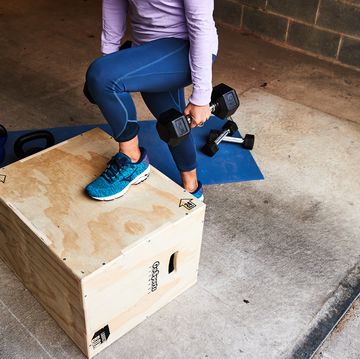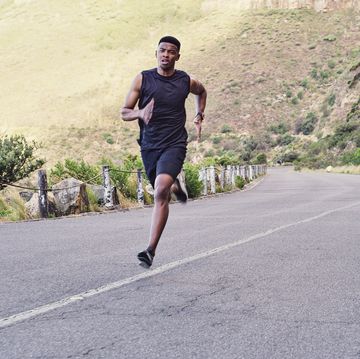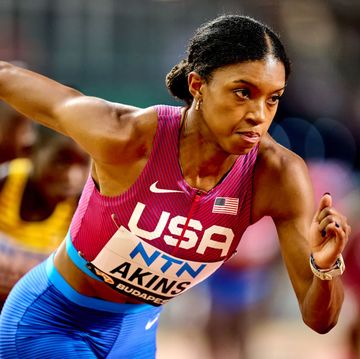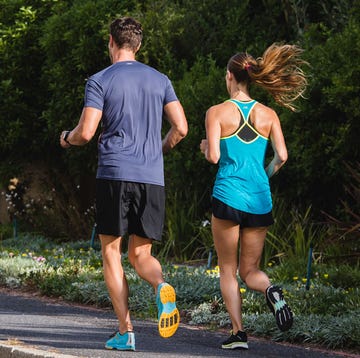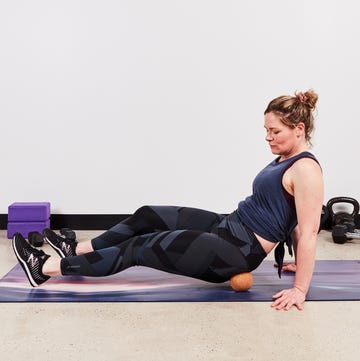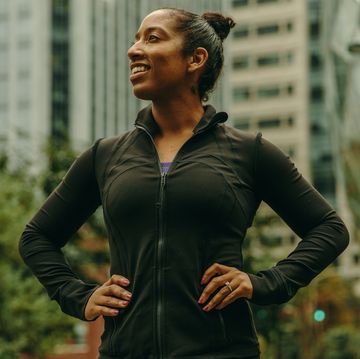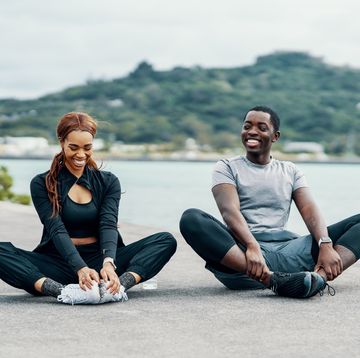I've spent more than 30 years reading scientific papers and abstracts on subjects of interest to me: running, fitness, health and related topics. No area has proven more perplexing, confusing and just-plain unsubstantiated than EPOC--excess post oxygen consumption, popularly known as "after burn." That is, the calories you burn after exercise as your body transitions from a revved-up state to its normal functioning.
In fact, I had come to consider EPOC as a non-event. Results from studies were so conflicting that I had lumped EPOC in the part of my brain labeled "likely fitness mythology." I didn't believe in it.
No more. In one of the best studies I've ever read, by one of the most precise exercise physiologists I known, Dr. David Nieman, Ph.D., has shown that EPOC is real and significant. You DO burn a lot of calories after exercising, at least if you exercise at an intensity roughly equal to 70 percent of your vo2 max. That's a little slower than your marathon pace, but a little faster than your everyday EZ run pace.
In Nieman's study, a group of 10 healthy young-adult males (including three clinically obese subjects) burned 519 calories while exercising for 45 minutes on an exercise bike. Then, over the next 14 hours, they burned an additional 190 calories. That's a 37 percent boost over their calories burned on the bikes.
Another way of looking at it: If you burn 500 calories by running about 5 miles, you can gain almost another 2 miles of running through your after-burn calories. Thus, 5 miles becomes 7 miles, at least in terms of calorie-burning. That's great news for runners and other vigorous exercisers.
We can have confidence in Nieman's study results because he used a $1 million metabolic chamber to track subjects' calorie burn on a non-exercise day, and also on their exercise day. A metabolic chamber is like a teensy-weensy hotel room that literally measures every breath you take for 24 hours. A metabolic chamber determines your oxygen consumption, and from that your calorie burn.
The intensity (effort) of your workout is important. Some previous studies of low-intensity workouts--like strolling around the block--has shown that they produce little to no EPOC. Nieman says you have to work hard enough to break into a good sweat. Or, more technically, he notes that you have to produce a "homeostatic disturbance." This includes: an sizeable increase in body temperature; higher heart rate and blood pressure; a drop in muscle glycogen supplies; and an elevation of stress hormones significantly higher than normal.
Dr. Nieman, a professor at Appalachian State University in Boone, NC, has spent the last 30 years establishing himself as the world-leading expert on exercise and immunity. He's the guy always quoted by Runner's World and other media during cold and flu season. With the new metabolic chamber, located at the University of North Carolina in Kannapolis, he's edging more toward the obesity-public health issue. As he concludes in the new paper, published in Medicine & Science in Sports & Exercise: "The magnitude and duration of increased energy expenditure following a 45-minute bout of vigorous exercise may have implications for weight loss and management."
I'll say. Big implications. Your workout burns calories two ways: during, and after the exercise. And the after-exercise component can add more than 1/3rd to your total calorie expenditure. That should provide plenty of motivation to go just a little bit harder.
Below, David Nieman, DrPH, health professor and director of the Human Performance Lab at Appalachian State University in Boone, NC, answers several questions about the new study.
Runner's World: You've been known for a long time as the exercise-immunity guy. Does this metabolic work represent a new career path for you?
David Nieman: No, I'll continue to focus on immunity issues. But I've developed a good working relationship with the people at the University of North Carolina-Chapel Hill, and they have this new, state-of-the-art metabolic chamber, so we're working on several projects together. The EPOC paper was the first.
RW: Were you surprised by the magnitude of the effect you observed--the 37 percent additional calories burned after exercise?
DM: Yes. I knew many of the previous studies had methodological shortcomings, but I still didn't expect that our subjects would continue burning calories for much more than an hour after exercising. We figured we'd just confirm that one-hour finding from some previous studies. Instead our subjects continued burning calories at a nice, steady level for about 14 hours. It added up to an additional 190 calories. Yes, I was surprised by that.
RW: How much did the intensity level of their workout contribute to the EPOC?
DM: That's a good question. We think it was very important. In another study similar to ours, the subjects did a light walking exercise, and they had basically no EPOC after exercising.
RW: In the paper, you say that the exercise has to be sufficient enough to cause a "homeostatic disturbance." What does that mean?
DM: The exercise has to be enough to make you work up a good sweat. It's exercise you can handle, but it feels somewhat hard. It will have a fairly significant effect on your body temperature, and your heart rate and blood pressure. It will deplete your glycogen stores. It will raise your stress-hormone levels. When a workout does all these things, it will take your body quite a while to get itself back to homeostasis.
RW: Some of your subjects weren't particularly fit. How did they manage to do this workout?
DM: You're right. Three of our subjects were actually obese. But we found, and I think that this is part of the good-news aspect of this study, that they could still do a stationary bicycle workout for 45 minutes at 75 percent of their vo2 max. They were working hard, but they could handle it.
And then they got this quite-high calorie burn for 14 hours after the workout. They exercised before noon, and they were still getting the extra calorie burn at 2 am when they were asleep. It's like a bonus. It's a good way to motivate people to do the workout. And if they do it just twice one week, and three times the next week, they're going to lose a pound of body fat in two weeks. Of course, they have to be careful not to overcompensate in their eating. You always have that. People always have to practice some restraint in their eating.
Over the last 30+ years, I've read countless scientificpapers and abstracts on subjects of interest to me: running, fitness, health and related topics.
No area has proven more perplexing, confusing and just-plain unsubstantiated than EPOC--excess post oxygen consumption, popularly known as "after burn." EPOC refers to the calories you burn after exercise as your body transitions from a revved-up state to its normal functioning.
In fact, I had come to consider EPOC as a myth. Results from studies were so conflicting that I had dumped EPOC in the part of my brain labeled "likely fitness untruths." I didn't believe in it.
No more. In one of the most fascinating studies I've ever read, by one of the most precise physiologists I know, it has been established beyond any doubt that EPOC can be both real and significant. David Nieman, DrPH (photo above), and colleagues have shown that you DO burn a lot of calories after exercising, at least if you exercise at an intensity roughly equal to 70 percent of your vo2 max. That's a little slower than your marathon pace, but a little faster than your everyday EZ run pace.
In Nieman's study, a group of 10 healthy young-adult males (including three clinically obese subjects) burned 519 calories while exercising for 45 minutes on an exercise bike. Then, over the next 14 hours, they burned an additional 190 calories (above their normal calorie burn) while just sitting around.That's a 37 percent boost beyond the calories burned on the bikes. Another way of looking at it: If you burn 500 calories by running about 5 miles, you can gain almost another 2 miles of running through your after-burn calories. Thus, 5 miles becomes 7 miles, at least in terms of calorie-burning. That's great news for runners and other vigorous exercisers.
We can have confidence in Nieman's study results because he used a $1 million metabolic chamber to track subjects' calorie burn on a non-exercise day, and also on their exercise day. A metabolic chamber is like a teensy-weensy hotel room that literally measures every breath you take for 24 hours. The chamber determines your oxygen consumption, and from that your calorie burn.
The intensity (effort) of your workout is important. Some previous studies of low-intensity workouts--like strolling around the block--had shown that they produce little to no EPOC. Nieman says you have to work hard enough to break into a good sweat. Or, more technically, he notes that you have to produce a "homeostatic disturbance." (See interview below for more.)
Dr. Nieman, a professor at Appalachian State University in Boone, NC, has spent the last 30 years establishing himself as the world-leading expert on exercise and immunity, including this classic study. He's the guy always quoted by Runner's World and other media during cold and flu season. With the new metabolic chamber, located at the University of North Carolina in Kannapolis, he's also on the cutting-edge of obesity-public health issue. As he concludes in the new paper, published in Medicine & Science in Sports & Exercise: "The magnitude and duration of increased energy expenditure following a 45-minute bout of vigorous exercise may have implications for weight loss and management."
I'll say. Big implications. Your workout burns calories two ways: during, and after the exercise. And the after-exercise component can add more than 35 percent to your total calorie expenditure. That should provide plenty of motivation to go just a little bit harder on your next workout.
Below, David Nieman, DrPH, health professor and director of the Human Performance Lab at Appalachian State University in Boone, NC, answers several questions about the new study.
Runner's World: You've been known for a long time as the exercise-immunity guy. Does this metabolic work represent a new career path for you?
David Nieman: No, I'll continue to focus on immunity issues. But I've developed a good working relationship with the people at the University of North Carolina-Chapel Hill, and they have this new, state-of-the-art metabolic chamber, so we're working on several projects together. The EPOC paper was the first.
RW: Were you surprised by the magnitude of the effect you observed--the 37 percent additional calories burned after exercise?
DM: Yes. I knew many of the previous studies had methodological shortcomings, but I still didn't expect that our subjects would continue burning calories for much more than an hour after exercising. We figured we'd just confirm that one-hour finding from some previous studies. Instead our subjects continued burning calories at a nice, steady level for about 14 hours. It added up to an additional 190 calories. Yes, I was surprised by that.
RW: How much did the intensity level of their workout contribute to the EPOC?
DM: That's a good question. We think it was very important. In another study similar to ours, the subjects did a light walking exercise, and they had basically no EPOC after exercising.
RW: In the paper, you say that the exercise has to be sufficient enough to cause a "homeostatic disturbance." What does that mean?
DM: The exercise has to be enough to make you work up a good sweat. It's exercise you can handle, but it feels somewhat hard. It will have a fairly significant effect on your body temperature, and your heart rate and blood pressure. It will deplete your glycogen stores. It will raise your stress-hormone levels. When a workout does all these things, it will take your body quite a while to get itself back to homeostasis.
RW: Some of your subjects weren't particularly fit. How did they manage to do this workout?
DM: You're right. Three of our subjects were actually obese. But we found, and I think that this is part of the good-news aspect of this study, that they could still do a stationary bicycle workout for 45 minutes at 75 percent of their vo2 max. They were working hard, but they could handle it. And then they got this quite-high calorie burn for 14 hours after the workout. They exercised before noon, and they were still getting the extra calorie burn at 2 am when they were asleep. And if people will do a workout like this just twice one week, and three times the next week, they're going to lose a pound of body fat in two weeks. Of course, they have to be careful not to overcompensate in their eating. You always have that. People always have to practice some restraint in their food consumption.


